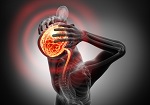
If you're familiar with the Sunday comic Pogo, you may remember him saying "We have met the enemy and he is us." It's a fitting description for COVID-nineteen. That's because our bodies sometimes over-react to an infection and attack our own tissues.
In a recent study, scientists at the National Institutes of Health found brain damage in COVID patients who died. Most people think of this disease as a respiratory one, but it's more than that. People have reported dizziness, fatigue, delirium, the loss of smell and taste, headache and even stroke.
Powerful MRI scans found damage to small blood vessels in the brain called microvasculatures. They became thin and leaky. But what's surprising is the virus was rarely found there, why? Because it's the body's inflammatory response from our activated immune system that caused the damage. Its goal was to control the infection, but in that effort, healthy tissue was also sacrificed. That's why some COVID patients have damage to their kidneys, heart and even the brain.
This study looked at twenty patients who died. The MRI scans showed bright areas of inflammation and dark spots where blood leaked from damaged blood vessels. It's similar to what you'd see in stroke patients. Understanding this process helps doctors learn how to better treat patients. Since symptoms of COVID-nineteen may last years, new interventions are even more important to a full recovery.
More Information
Study reveals brain damage of patients with COVID-19
Study uncovers blood vessel damage and inflammation in COVID-19 patients' brains but no infection...
Microvascular Injury in the Brains of Patients with Covid-19
In a convenience sample of patients who had died from Covid-19, multifocal microvascular injury was observed in the brain and olfactory bulbs by means of magnetic resonance microscopy, histopathological evaluation, and immunohistochemical analysis of corresponding sections, without evidence of viral infection. These findings may inform the interpretation of changes observed on magnetic resonance imaging of punctate hyperintensities and linear hypointensities in patients with Covid-19...